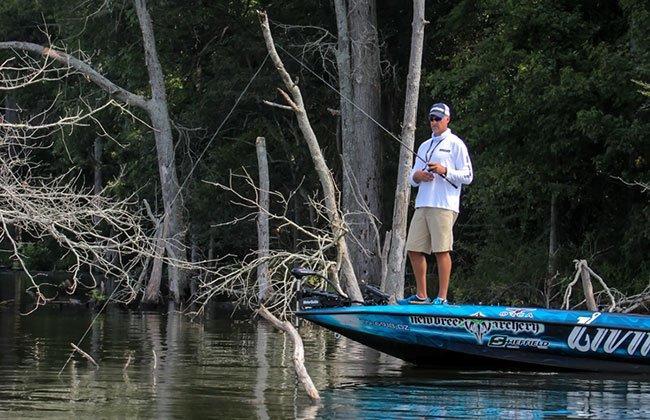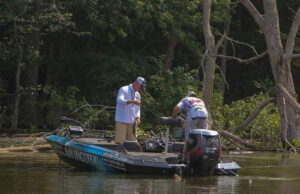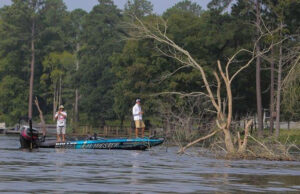Hot weather, warm water and subpar oxygen levels aren’t necessarily the best ingredients for prime bass fishing action. Compound these factors with a scattered population of transitioning bass and September can be a tricky time for anglers. If you’re having a hard time getting bites, head up the river of your favorite reservoir where the water is compacted and so are the bass.
FLW Tour pro Andy Morgan is a renowned expert at dissecting skinny water. His ability to quickly identify productive areas on the upper ends of reservoirs has played an integral role in his 2013 and 2014 Angler of the Year titles.
According to him, concentrating on these areas can produce consistent numbers of bass when the bite gets tough.
Three primary factors
If you follow professional bass fishing, you know Morgan as one of the most consistent anglers in the sport. Many of his competitors joke that he wakes up with a limit of bass in his livewell each morning. A large part of his consistency stems from the areas he decides to fish each tournament.
“In all honesty, the bigger fish actually live on the bottom end of almost every lake we visit,” Morgan said. “But I’ve found that day-in and day-out, the upper ends give me the best opportunity to get bites when it’s tough.”
“In all honesty, the bigger fish actually live on the bottom end of almost every lake we visit,” Morgan said. “The deeper water and bigger creeks give those big bass a major sense of security. But I’ve found that day in and day out, the upper ends offer me a better chance at getting more bites this time of year.”
Morgan attributes this reliability to 3 important factors— bluegill spawns, available cover and fresh water.
- Bluegill spawn —”The upper ends of most reservoirs are absolutely loaded with bluegill,” Morgan said. “A lot of people think the bluegill spawn is only an early summer type of thing, but those suckers will spawn on every full moon until the end of the summer. So if you can get out there within a few days of that full moon, you’re bound to have a memorable day on the water.”
- Available cover—”It seems like the bottom ends of reservoirs are often most developed,” Morgan said. “Homeowners will remove laydowns and spray grass beds which results in less bass habitat. When you head up to the rivers, you’ll find all sorts of cover up there. When you’re dealing with really warm water temperatures, all of that cover acts as extra enticement for bass to be shallow and active.”
- Fresh water—”I think the fresher water on the upper ends also makes the fish stay shallower and more active for longer periods of time,” Morgan said. “Hot, stagnant water is not a good thing and these areas can offer current and some cooler runoff.”
Birds, bait and bends
Morgan takes a very simplistic approach to bass fishing and it’s hard to argue with the results. While he believes there is no substitute for quickly covering water, there are a few special things he looks for in addition to what he refers to as “the standard stuff” such as laydowns, logs and vegetation.
- Birds—”The presence of birds is a good indicator of nearby bait,” Morgan said. “And of course, where there is bait, there will be bass. So just like you’d do on the bottom end of a fishery, keep an eye out for diving birds. When I see bird activity, I’ll stop and check it out every single time.”
- Outside bends— “A little deeper water can be hugely important when you’re fishing this skinny water,” Morgan said. “Outside river bends get washed out by the current, creating deeper water and logs will often accumulate in these areas. These areas attract huge piles of baitfish, crawfish, bluegill and of course bass. Always spend some time looking for outside bends.”
- Inside bends—”When there is current present, inside creek or river bends can play a really big role,” Morgan said. “These bends provide bass with an almost perfect ambush point. As the current washes down the river, it brings a bunch of bait with it. The bass will sit in the slack water in these areas and just wait for the food to come to them.”
- Don’t overlook the flat banks—”Flat banks don’t always look appealing but as fall gets closer, the shad will get in these areas and it will be a feeding frenzy,” Morgan said.
Complications of up-river fishing
Fishing skinny water can be a double-edged sword at times. You’re going to be around plenty of active bass, but a lot of things have to go just right in order to put together a sizeable limit. According to Morgan, these four factors can really hurt the bass fishing action on the upper ends of reservoirs.
Morgan’s favorite baits for skinny water
- War Eagle Flipping Jig
- Texas-rigged Zoom Z Hog
- War Eagle Spinnerbait
- Livingston Lures squarebill crankbait
- Fluctuating water—”Fluctuating water is not a good thing and it’s very tough to keep up with,” Morgan said. “Bass generally follow the water level, so when it’s high, they’ll go shallower. When it drops, they’ll often slide out to secondary cover. But if the water drops too much, you might not be able to get back to your best areas. Even worse, it can drop while you’re fishing and leave you stranded.”
- Muddy water—”A lot of fresh mud is the kiss of death when you’re fishing these areas,” Morgan said. “These are volatile areas because they’re going to be affected almost immediately by runoff. You have to stay on your toes and pay very close attention to the weather. If I see a bunch of new mud, I’ll turn right around and find somewhere else to fish.”
- No current—”A lack of current can make the bite incredibly slow,” Morgan said. “Current is what brings these upper ends to life—it makes everything more active.”
- Boat traffic—”I used to be able to run up in these skinny areas and get away from other anglers,” Morgan said. “That’s not the case anymore. When you have company in an area, you’re dividing a finite population of bass and that can make it really tough. If other anglers are in the same area, I’ll try to lay off the main river stuff and head back into some sloughs to find some uneducated fish.”
There’s no substitute for good casting
Morgan is one of the most accurate shallow water casters this sport has ever seen, and it’s not by accident. He cut his teeth in the shallow waters of small creeks and rivers and quickly learned the bass didn’t swim from far away to eat his bait. He almost had to hit ’em in the head to make them eat.
“It’s tempting to think the fish in these skinny waters are easier to catch due to less fishing pressure,” Morgan said. “But that’s certainly not the case. I think they’re tougher to fool because you have to make quieter and more precise casts because they’re super spooky in that shallow water. If you miss your target by an inch or make a splash that alerts the fish to your presence, you’re not going to get a bite. I can’t stress the importance of good casting enough.”
If the bass fishing has been tough for you lately, there’s a great chance the upper end of your favorite reservoir can provide you with some much needed relief. If you can find birds and bait while understanding what conditions help and hurt these areas, you’ll have a set of bruised ribs while other anglers struggle for bites.














